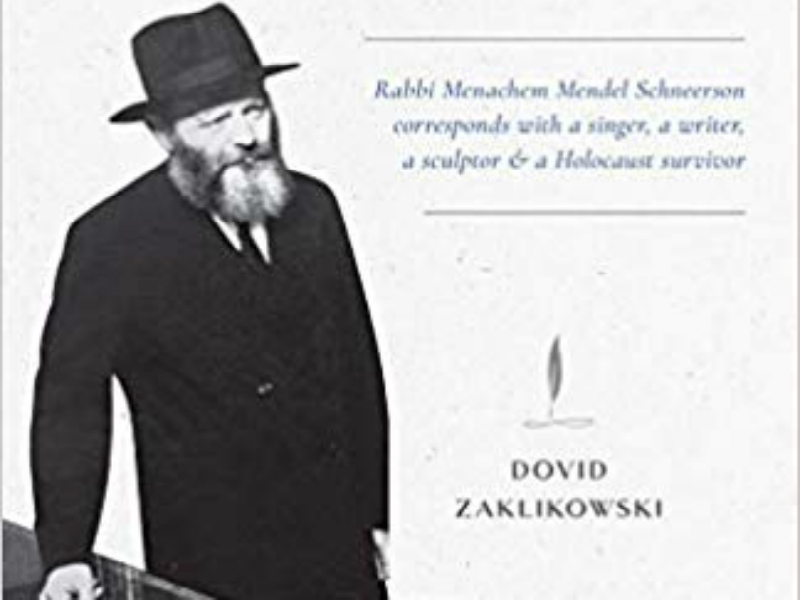Lubavitcher Rebbe Menachem Mendel Schneerson (1902-1994) was one of the outstanding Jewish leaders of the 20th century.
Known simply as “the Rebbe,” what made him unique was his influence, his breadth of knowledge, both Jewish and secular, his wide-ranging interests, his welcoming of all kinds of Jews, his ability to organize and his capacity for spreading Jewishness to all corners of the world. Born in Russia, Rabbi Schneerson was educated there and at the University of Berlin. The future Lubavitacher rebbe also studied mechanics and electrical engineering at the prestigious Sorbonne University in Paris.
In Dear Rebbe, a meticulously researched and continuously fascinating book, edited and compiled by Dovid Zaklikowski, we have stories and letters to and from the Rebbe, written in Yiddish and English, about three internationally renowned Jewish artists: opera singer Jan Peerce, sculptor Jacques Lipschitz, as well as Yiddish poet and novelist Chaim Grade. All were native Yiddish speakers.
The book begins with an illuminating 30-page prologue that offers a lucid introduction to the Lubavitcher rebbe and his accomplishments. The following lines succinctly depict Rabbi Schneerson’s view of Jews:
“The Rebbe’s openness to engagement with secular Jews was such that he spurned what he saw as artificial distinctions between the observant and the non-observant. In his view, every Jew is indispensable to the nation as a whole, entitled to a community that will support them and connect them to their heritage.”
Jacques Lipschitz (1891-1973) came from a traditional family in Lithuania, but, encouraged by his mother, moved to Paris in 1909 to study at the famous Ecole des Beaux Arts. There, he met other artists who, like him, would achieve international renown: Marc Chagall, Juan Gris, Pablo Picasso and Amedeo Modigliani.
When the Germans invaded France in 1940, Lipschitz and his wife successfully escaped and made their way to the United States. During a visit with the Rebbe at the Lubavitch world headquarters in New York, the Rebbe told the sculptor to put on tefillin daily, which Lipschitz continued to do to the end of his life.
When Lipschitz was commissioned to create a Christian sculpture for a church, he told the church official that he would agree only if some words about his Jewishness were inscribed at the bottom. The words read: “Jacob Lipschitz, Jew, faithful to the religion of his ancestors.”
After his death in Milan, the sculptor left his Italian property to Chabad, to be used as an overnight camp.
READ: YIDDISH FICTION FOR THE ENGLISH-SPEAKING MASSES
The great Metropolitan Opera tenor, Jan Peerce, who also recorded classic Yiddish folksongs, is the next artist featured in the book. Peerce came from a traditional Jewish home and was thoroughly familiar with Jewish liturgy – to the extent that he was able to make a record, titled Cantorial Masterpieces, which he presented as a gift to the Rebbe.
Peerce’s solo singing as a youngster at Radio City Music Hall attracted the attention of legendary conductor Arturo Toscanini, who hired Peerce to sing with the NBC Symphony Orchestra.
Although Peerce would perform on Shabbat, he put on tefillin daily, prayed and always kept kosher. When Peerce discovered the wordless nigunim (melodies), he called them a revelation. In a letter to Peerce, the Rebbe wrote that, “Hasidic song and melody inspires one’s whole being … that’s why they occupy such an
important place in Hasidic life and in Jewish life in general.”
After Peerce died, the music commentator Martin Bookspan recalled the thrill of hearing the tenor making Kiddush in his home on Friday evening.
Of all the artists included in Dear Rebbe, the one with the most thorough grounding in Yiddishkeit was novelist and poet Chaim Grade (1910-1982). A master of Yiddish and Hebrew, Grade abandoned the traditional way of life as a young adult, once he became involved with the secular writers of his generation.
I first learned of his link to Chabad when I visited Grade years ago in the Bronx, a few days before Pesach. A moment after I came in, he showed me a white box. He proudly told me that the Rebbe’s personal shaliach (messenger) had sent him the box of shemurah matzah. Of the Rebbe, Grade said: “He seeks to bring heaven closer to earth and earth closer to heaven.”
One page in the Chaim Grade section shows a photocopy of his handwritten Yiddish letter to the Rebbe: “To the dear Rebbe, who stands before my eyes and who also elevates my sparks that stumble blindly through the fog and are drawn to his light.”
As secular as Grade was, he once tried to persuade a young Chabadnik not to abandon his traditional way of life and “not to impoverish our Jewish nation with another Jew who has uprooted himself from our midst.”
Dear Rebbe, which includes lots of fascinating photographs, is a treasure of a book that will appeal to Jews of all types – for all of them are, in the view of the Rebbe, tayere yidn, precious Jews.
